
Preview
E.C. Meade and Jim Clark Review The Latest Videogames.
Frostbite
Activision for the 2600
Object
Frostbite Bailey is trying to build an igloo at the top of the screen. To do this, he must jump from floe to floe as the neat rows of ice float across the screen.
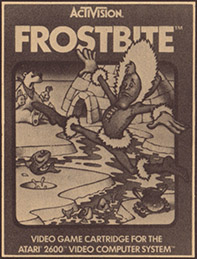
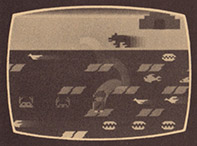
Each chunk of ice Bailey touches causes that row to change color. It also adds a block to his igloo. When he has landed once upon each row of the screen, they change back to their original colors and he starts again. It takes more than one screen of floe-hopping to build an igloo.
When the igloo is built, Frostbite races inside for extra points.
Menacing Frostbite at different levels are Alaskan King Crabs, Snow Geese, Killer Clams, and Polar Grizzlies, all of whom will deep-six Mr. Bailey.
Meanwhile, you must also keep an eye on the thermometer. The longer Frostbite works, the colder it gets. When it reaches zero degrees, our hero freezes.
Gobbling down the fish which pass by on occasion warms things up and buys Bailey time.
The player begins the game with four Baileys. A new Frostbite is added every five thousand points, though you can accumulate no more than nine.
J.C.: Except for the sense of deja vu, I found this a wonderful game. Yes, the ice moving left-to-right and right-to-left in alternating rows is like Frogger and Activision’s own Freeway. Yes, the changing colors of the ice blocks, and especially the accompanying sounds, are like Q*Bert.
But you get it all in one appealing game!
I like the fact that you can use the action button to change the direction of the ice floe on which you’re standing-at the cost of a block of igloo ice—and the prowling Polar Grizzlies are as formidable a videogame foe as we’ve seen in quite a while.
I also am impressed by the ambience of the game: the colors are vivid and the design is so well done you’ll feel the chill.
A solid, if not trailblazing game.
Graphics: B
Gameplay: B-
E.C.M: I can sum up Frostbite in one word: eh!
Frostbite is slow by the standards of Enduro and River Raid and just too patchwork to be effective. In trying to pack the excitement of Q*Bert and Frogger into one cartridge, Activision has failed to give it a distinctive look and feel of its own.
Remember Megamania? How that took the Space Invaders theme and carried it the next logical step?
Then there was Pitfall, which had movement and sweep.
Even Oink!, which gave us Breakout in reverse.
Until recently, Activision was always thinking of a new approach, creating new “tunes” or working incredible “fugues” on old ones. Frostbite isn’t so much a tune as a record which skips from groove to groove.
Activision is no longer evolving themes, it’s putting them into a blender. This is yet another step in the company’s surprising decline.
Graphics: C-
Gameplay: C-
Sewer Sam
Interplay for Intellivision
Object
Sewer Sam has to clear the city’s sewers of various venomous creatures such as bats and snakes.
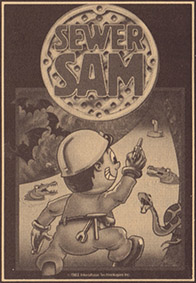
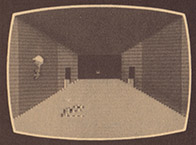
You are looking out from behind Sam’s shoulder as he makes his way through the underground network. Nasties come at you from ahead, squirming low, flying high, poking up from the water through which you’re sloshing. There are even enemy submarines lurking in the bowels of the city.
All you can do is fire at these various nemeses, or run to the walls and scale them until the danger passes.
E.C.M.: Interplay, a Canadian company, promises to have this game and its companion available for ColecoVision and other systems soon.
I hope so. They do good work.
Sewer Sam is a computer-quality game, one of the few point-of-view cartridges on the market. The sewer walls scroll past realistically, and the creatures are all well animated. Sam himself is particularly well drawn, especially in his death throes whenever one of the villains tags him.
Although I have some quibbles about the fact that you can’t aim your shots so much as approximate them, this didn’t seriously detract from my enjoyment of the game.
A terrific Intellivision cartridge, and an impressive programming achievement.
Graphics: B +
Gameplay: B+
J.C.: Although I wouldn’t rate this as highly as E.C. does, 1 like the sense of lurking menace which hides along every sewer. The patterns are always different, and there’s always a sense of discovery.
I particularly like the doorways which poke through each sewer now and then, and allow you to enter another tunnel, one which may or may not be flooded. You can move faster in those passageways where there is no water.
Still, once you’ve played Sewer Sam a few times, you’ll have seen all there is to see. Nor do the sewer dwellers ever come fast enough to make even that terribly exciting.
Unique, yes. Breathtaking, no. Good for cowards? The wall-hugger mode is tailor-made for players with a yellow streak. A welcome change of pace from the interminable Dungeons & Dragons type catacomb games? Without a doubt!
Graphics: B
Gameplay: C
Blockade Runner
Interplay for Intellivision
Object
You are in the cockpit of a space freighter, racing to your home world with vital supplies. But alien enemies have blocked the route; your only chance of getting through is to swerve through an asteroid belt.
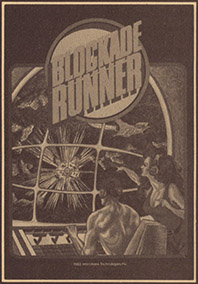
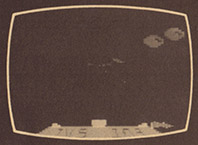
Asteroids fly at your ship; likewise robot space mines sent by the aliens and, finally, the aliens themselves. Each of these damages your vessel to varying degrees.
In addition to blasting these foes from the stars, you have deflector shields to help preserve you.
All the while you must keep an eye out for clouds of ice crystals. When the coolant for your ship’s nuclear reactor runs out, you must replenish it or perish.
J.C.: I fear that Blockade Runner comes a little late in the day for either the space adventure craze or the Star Trek / Star Voyager / Space Master / Star Raiders line to have a commercial prayer.
A pity, since it’s the best game of the lot and the only cartridge of its kind for Intellivision (discounting Space Battle, which offers only a fixed-position view).
The action in Blockade Runner is not only faster than fast, you command retrorockets which allow you to shift the action to the left, right, top, or bottom. That enables you to slide from the flow of enemies while shooting back.
The graphics are superb, and the sound effects resounding. Moreover, the game can be set up so that one player controls the missiles, the other the ship’s velocity and steering.
Now if only Interplay had done something with the Intellivoice…
Graphics: A
Gameplay: A-
E.C.: As Jim has said, this is a stupendous job on a tired theme, sort of like making the world’s best Big Mac. What was exciting a few years ago just isn’t exciting any more.
What Interplay should have done was get the rights to the Monty Python characters and done Blockhead Runner, something odd or perverse to breathe some life into the genre.
As it stands, Blockade Runner is state-of-the-art spacefaring in almost every way. Although I sometimes found the enemy objects difficult to tell apart due to the speed of their approach, the distraction was negligible.
I look forward to more games from this company. C’mon in, the water’s evaporating.
Graphics: B+
Gameplay: B+
Stronghold
CommaVid for the 2600
Object
As an agent of space security, you must pilot your saucer over the surface of the asteroid Stronghold, where your job is to rid it of waste which floats through the atmosphere. Your gun can be turned 360 degrees for this purpose.
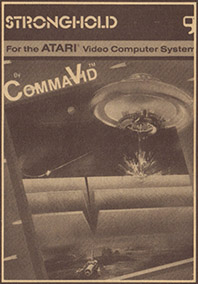
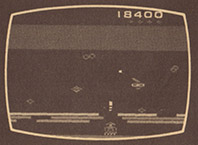
However, while there you discover a lethal Asteroid Crawler beneath three moving, energized Force Shields. The Shields must be picked apart while you try to blast a window through to the Crawler. Meanwhile, it can fire back at you.
In advanced levels, a Mega-Field slowly descends through the atmosphere of the asteroid, limiting by ever increasing chunks the room in which you have to maneuver.
E.C.M.: This is a lousy game. Apart from being yet another variation of Odyssey’s U.F.O.—and not as flashy or exciting, I might add—Stronghold is far behind the state-of-the-art in videogaming. I can’t help but believe that Comma Vid is someone’s tax writeoff.
The colors: drab. Gameplay: the ship is a pain to rotate. Only the debris itself are interesting, well-defined abstracts which have a nice, weightless quality to them.
Whoever designed this one must have been hibernating. Playing it, you will sleep too. Maybe they should change the name to ComaVid.
Graphics: D+
Gameplay: D-
J.C.: Pro rating games has become E.C.’s most useless hobby. Comparing this to U.F.O. is pointless, since they are for different systems.
Taken on its own merits, Stronghold, as E.C. grudgingly hinted, is very strong on the antagonists. The debris follows your ship like a living shadow, and the Crawler is merciless gunning for you as soon as there’s an opening in the three Shields. I’ll admit that the player’s weapon is clumsy to maneuver, and the fact that its effective range is a radius of less than an inch hampers enjoy1mmt. CommaVid doesn’t seem to realize that players like to blast the hell out of enemies, not wait until they’re shoulder to shoulder to pick them off.
Graphics are sparse; a few stars in the sky might have been a nice touch.
I’m not recommending you spend more than twenty dollars; for that price, this is a good game.
Graphics: C+
Gameplay: C+
WABBIT
Apollo for the 2600
Object
As a farmer plagued by Rabbits, you are poised at the bottom of the screen awaiting each new onslaught. As the rabbits make their horizontal beelines, scurrying across your ten rows of crops, you must pelt them with rotten eggs.
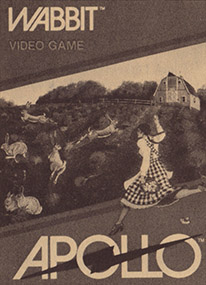
Each rabbit you smack turns from white to yolk-yellow, and earns you points.
E.C.: This was Apollo’s swan song-or rabbit song, as the case may be. The game received limited release before the company went under; we’re reviewing it now only because stocks of Apollo games are showing up on the discount tables and you may be inclined to pick it up.
Don’t.
This is a smeller in every sense of the word. The eggs travel with frustrating sloth; you get no more than two shots at each hare during any given pass. Moreover, if you stop a rabbit, the next rabbit will usually come from the same spot. Stop that one, and another appears, then another, until one succeeds. At that point, all the player needs to do is get a rhythm going.
Boring.
If the game had any charm, it might be worth a few bucks. But there’s none of that either. Remember the neat little dance the chicken did when hit in U.S. Games’ Egg-O-Mania? You won’t see any of that here.
There is something telling in the fact that Apollo’s last game is almost as bad as its first game, Skeet Shoot. Too bad they didn’t see the writing on the wall.
Graphics: D-
Gameplay: D-
J.C.: I’m convinced that E.C. came down so hard on this game because the egg-slinging isn’t lightspeed-fast. You actually have to aim, not always firing reflexively when a bunny first appears but tracking it and plugging the animal a beat later.
Be that as it may, there are flaws. This is a tough game for little kids, whose inability to time their shots will bag them few hares; it’s also too deliberate for action fans, and just too one-dimensional for hardened videogamers. Novices will enjoy it, as well as those who don’t mind a limited challenge, change-of-pace game for a few dollars.
Graphics: D
Gameplay: D+
ROCKY SUPER ACTION BOXING
Coleco for ColecoVision
Object
You take the part of either Rocky or Clubber Lang trying to beat your opponent insensate in three sixty-second rounds. The cartridge allows you to play the computer or another videogamer.
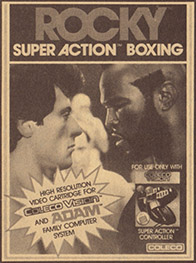
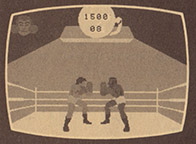
There are four basic maneuvers: right to head, right to body, left raised in defense, and duck.
Each round is a minute, and there are both Daze and Fatigue Indicators to show how weak or disoriented your boxer is becoming.
For use only with the new Super Controllers.
J.C.: I’m extremely disappointed with Rocky for a number of reasons. First, of the three boxing games, the technical presentation is inarguably the best. The animation is astonishingly fluid and detailed, and the Rocky music is superbly done. However, for those qualities I could have rented Rocky III on videocassette.
The Intellivision boxing cartridge has all of the Coleco features plus the ability to “build” your own fighter, emphasizing strength, endurance, speed, etc. Here, the pugilists are evenly matched.
Activision’s Boxing isn’t as versatile but it allows you to hammer away relentlessly. It moves many times faster than either of the more “sophisticated” cartridges.
The Rocky figures cannot move around the ring as quickly as the characters in either of the other two games, nor can they leave their half of the ring!
The qualifier, of course, is that ColecoVision owners may not have the other units. In that case, this is worth owning for its novelty and mild entertainment value. Otherwise, skip it.
Graphics: A
Gameplay: C-
E.C.M.: This is the worst cartridge Coleco has created for its system. The boxers move as though they were sloshing through fudge. Where’s the action, the speed, the guts?
Rocky only looks like a boxing game. It’s really an excuse to show off Coleco’s acumen with graphics. If the designers had organized their action elements with half the care that went into getting the Rocky title to crawl across Stallone’s figure in the attract mode, this would have been a classic.
Someone took a dive on this one. Compromised the gameplay for something that would look great in ads and in the stores. Shame on you, Coleco.
Okay, Parker Brothers. This is your chance to do an Ali game for ColecoVision and show us that you’re as good as your press releases insist.
Graphics: A
Gameplay: D
THUNDERGROUND
Sega for the 2600
Object
Commanding a subterranean tank, you must burrow up beneath six Vector nuclear bases located at the top of the screen. Placing your muzzle flush against each base in turn, you must blast them to atoms.
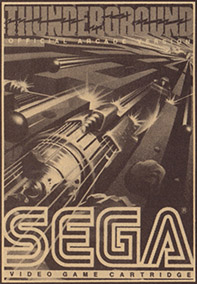
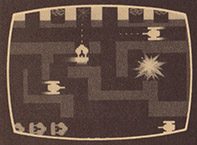
However, guarding the bases are a pair of Core Ranger Tanks. While you can obliterate each with a single shot, they can fire back and chase you into the tunnels you have excavated throughout the screen. Previously-launched shots survive the disintegration of each Core Ranger Tank.
E.C.M.: What a game! It’s a shame Sega folded up its home videogaming tent without giving this one a push, because it’s a sensational cartridge. But gutless business like that is the rule rather than the exception these days, a shame for seller and consumer alike.
Okay, there are superficial similarities to Dig-Dug and Mr. Do!, but this is a semi-clone with muscle! Crossing the corridor patrolled by the Core Ranger Tanks (CRTs, get it?) is a real challenge, as is escaping once you’ve blasted a base. (You can always abort a mission going in, but once committed must get out or get blasted.)
The graphics are nothing to write home about, but you really won’t care. A bargain at any price.
Graphics: C
Gameplay: A
J.C.: I’m going to stop considerably short of calling Thunderground a masterpiece, but it is a thrilling game. For me, the sense of deja-vu detracted from its appeal, along with the sparse screen—a few underground landmines would have been nice. Also, in later levels the “dirt” disappears and you’re playing on a barren black screen. While that gives the enemy Tanks more mobility, it eliminates the claustrophobic fun of waging a pitched battle within the confines of the maze of tunnels.
The chewing away of the earth is effective in the digging screens—it seems more particulate than the clumps which are devoured in the other burrowing games.
E.C. describes this as a semiclone of Mr. Do! or Dig-Dug, but with muscle. What she really means is violence, but I don’t think anyone will be too bothered.
Very good stuff, but far short of greatness.
Graphics: C+
Gameplay: B
OMEGA RACE
Coleco for ColecoVision
Object
As a starship commander in deep space, you must navigate your Omega craft around the screen and vaporize enemy Droids before they can mutate in to Death Ships.
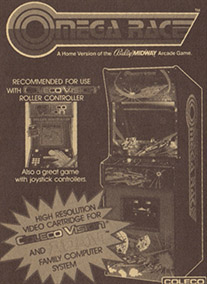
The field is weightless: in addition to your own thrust powers, your ship, if it hits the sides of the screen, will bounce off with equal force.
There are options which include a Tunnel (center of the screen) and Astra Gates (top and bottom) which can be used to sneak up on the enemy.
The screen is also littered with Vapor Mines and Photon Mines, deposited by Death Ships which have been around for longer than Omega Command would have preferred.
J.C.: Although this arcade game was out at the height of the Asteroids craze, the thrust-spin-fire theme is tired by now. Indeed, if you’ve got Coleco’s Space Fury, you’ve got all you need along those lines.
There are unique aspects of this game. The course is a rectangular doughnut, the center of which can’t be fired through or traversed, which makes it useful defensively, a bother offensively. Also, the rubber walls are not to be taken lightly: they can fling you where you don’t particularly want to go, or be used in a surprise offensive rebound into a heavily populated area.
But it isn’t enough to make this worth thirty dollars.
Graphics: C
Gameplay: C
E.C.M.: Sometimes, Jim shocks me. What he’s saying, in essence, is that if you’ve already tasted apples, stay away from apple pie since the only difference is some sugar and flour.
Omega Race is like playing four-wall handball. Granted, Asteroids et al got a little crazy when you overthrusted and had to avoid collisions. But this game throws you at right angles into other walls that throw you ninety degrees in some other direction.
Jim’s correct in ascribing plusses and minuses to this attribute. But mastering it all, while simultaneously having to do-in your adversaries before they start metamorphosing and dropping mines, is videogaming at its best.
No needlessly flamboyant graphics here, thank goodness; just great fun!
Graphics: B-
Gameplay: A
WORM WHOMPER
Activision for Intellivision
Object
Felton Pinkerton’s got a problem. There are waves of Inchworms, Snails, Slugs, Moths, Snakes, Millipedes, Caterpillars and other vermin moving from the right in order to eat the ten stalks of sweet, golden Corn on the left.
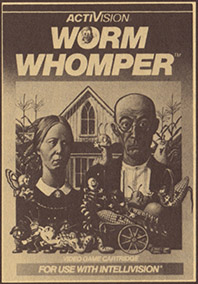
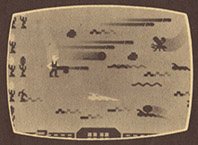
Corn dies upon contact with any bug other than an Inchworm. It changes color the first time an Inchworm touches it; the Corn dies the second time the insect gets it.
Felton has three means of beating a bug. Spraying it with his unlimited amount of Pesticide, he can stop Inchworms with one blast, Snails with two, Moths with three, and so on (not necessarily in succession; hits are cumulative). He can loose a Plough Ball, of which he has three per wave; these mow down every bug in their path. Finally, he can hit and destroy any insect with his Spray Gun. Doing that, however, Felton must get a new one from the Tool Shed at the bottom of the screen, wasting valuable time.
The bugs come at different angles, from straight to diagonal. The Moths lay Eggs, which others can hide behind to avoid Felton’s assault; these can be removed with Plough Balls.
E.C.M.: Don’t look for my name among the ranks of the Worm Whompers club; there’s no reason to take pride in the achievement. I scored the required 75,000 points right quick, and so should you. I’d have done it faster if I weren’t yawning.
On the one hand, this is Missile Command turned on its side: instead of cities you’re protecting Corn. However, you don’t have to sight and fire: this game’s just another slide-and-shoot. In fact, after a few waves there are so many bugs that you’ll be moving from top to bottom without ever taking your finger from the action button. Some fun, eh?
Incidentally, the insects are quite realistic, especially the Inchworms. If you don’t like little crawling things, all the more reason to stay away from Worm Whomper.
Another step toward limbo for Activision.
Graphics: C
Gameplay: D
J.C.: I took my licks, now it’s time for E.C. to get hers: never have I read a more limited review.
To wit: she doesn’t take into account the fact that scatter spraying only kills half the bugs on the field at best (you’ve got to do some precision shooting to get the rest); that your Corn has a way of dying fast whenever you’ve lost your Spray Gun and must fetch another (it happened to me more than once in high five figure play); and to hit a vermin three times before it reaches your Corn is not just a matter of firing three short bursts, since they tend to move diagonally.
In other words, Activision may have (intentionally?) set too low a score to join their Worm Whomper’s club, but very few players are going to penetrate far into six figures without a lot of practice.
The cartoony graphics of the field contrast dramatically with the truly offensive nature of some of the wrigglers, but it’s a nice (if disgusting) visual balance.
A novel game for Intellivision, and a good game from the one-time champs of cartridge design.
Graphics: B+
Gameplay: B
DIG-DUG
Atari for the 5200
Object
Burrow your hero through the sands earning points as you dig and collect valuable vegetables. In the meantime, you must harpoon, pump, and explode various subterranean demons before they eat you.
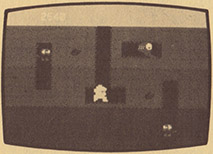
These evil Pookas and Fygars dwell in narrow tunnels and can’t leave them until you penetrate a wall thereof, or so much time has passed that they are permitted to flee.
Each round is completed when the four or more monsters have been slain or are able to wander off the side of the screen.
(Editor’s note: please see VCI #4 for a complete guide to conquering Dig-Dug.)
J.C.: This is a wonderful cartridge. The limited range of your harpoon, the dirt-penetrating fire breathed by the Fygars, and the fact that when your enemies leave their tunnels they can cut diagonally across the screen—not just in a straight line—makes this more entertaining by far than Mr. Do! over at Coleco.
The graphics are not as detailed as seasoned diggers might like. The variegated earth colors are all there, but the figures themselves are only a shadow of what they are in the arcades. Particularly disappointing is that after all the pumping of the nasties you don’t get a distinctive ‘pop’ the way you do in the arcade.
Nonetheless, your journey into the underworld will be a very satisfying one. Admittedly, the rendering of each character is spare. Players may have to rely on memories of the arcade game to provide characterization. But what the heck—it’s a cartoon.
Graphics: C
Gameplay: B
E.C.M.: What I’ve always appreciated most about Dig-Dug is that you can pump the demons and then release them. Tactically, that stuns the creature and buys you time—time for the others to make their way to your position. When that happens, you can drop a rock on the lot of them and earn big points.
That wonderful strategic capacity is still here, but the game has other flaws.
I feel more strongly than Jim that the characterization in this home version detracts from one’s enjoyment. I can live with the horizontal stretch of the game vs. the vertical stretch in the arcades; and the soil underground is indeed every bit as detailed as the original Dig-Dug. But that little white ‘thing’ moving around the screen isn’t Dig-Dug, those blobs of color aren’t Pookas and Fygars, and the swelling of the creatures is unacceptably jerky.
Novices will enjoy the game; seasoned gamers will simply settle for it.
Graphics: C-
Gameplay: B-
MOUNTAIN KING
CBS for the 2600
Object
Deep within a long-lost diamond mine are level after level of gems—and, somewhere within, the Temple Chamber of a forgotten civilization. In this Chamber is a Golden Crown which, while worth a fortune, can only be had once the player has found and captured the Flame Spirit and offered it to the Skull Spirit which guards the treasure. The Flame Spirit only appears once the player has collected enough diamonds.
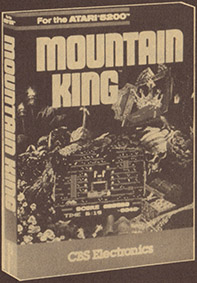
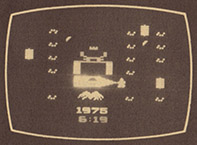
As the clock runs down, among the other challenges facing the player in her/his quest to become the Mountain King are, first, collecting enough diamonds to enable the Flame Spirit to appear; snaring the elusive spectre; eluding Cave Bats, which can steal the Flame Spirit; and the Giant Spider which snares you in its web and, if you take too long escaping, eats you.
Even after you get the Crown, if you don’t climb all the way back to the mountaintop before time runs out or Cave Bats steal your find, the game ends.
E.C.M.: In a phrase, this is the best quest game I’ve played since Atari’s Adventure.
What distinguishes a good game of this type from a great one is the random generation of characters, the complexity of the maze—or, in this case, an endlessly high mountain whose levels and pitfalls require Herculean jumps—and the unusual nature of the search.
In the case of Mountain King, there is little concern for graphics: everything’s gameplay. You race to collect diamonds as fast as possible, leap at—and invariably miss—other levels, run like a lunatic to avoid the Spider, and start to huff in annoyance as the Flame Spirit proves elusive (it is visible only when you shine your flashlight where there’s a hint of flame).
Particularly entertaining, if frustrating, is the fact that falling off certain ledges can drop you for more levels than even exist in most games. You won’t die upon finally striking ground, you’ll just be dazed…while the clock ticks away.
Though you never get to build up a real head of steam as you do running through the mazes in Adventure or the much-underrated Haunted House, Mountain King is a grand escape and an innovative challenge.
Graphics: D
Gameplay: B+
J.C.: I appreciate E.C.’s enthusiasm as far as the scope of the game is concerned, for the mountain is indeed many-leveled. For me, however, it was just a slightly more convoluted version of the climb-and-duck Donkey Kong motif. I’m all for fleshing-out games, mind you—but this stuff is mere padding. Whatever you do, you’re still jumping and running: in Adventure, there were times when you had to go and find a spear, stop to slay a dragon, rush out and get a bridge to ford walls. In short, there was variety.
What’s here is good, but not so unique that you’re going to have hour after hour of fun.
Incidentally, It would have been fitting if, somewhere in their instruction booklet, CBS had credited the game’s famous Hall of the Mountain King music to Norwegian composer Edward Grieg.
Graphics: D
Gameplay: C
SPACE SHUITLE
Activision for the 2600
Object
You are in command of the Discovery in this true-to-life simulation of a Shuttle mission. After liftoff, during which you help mission control run the engines and manage trajectory, you enter orbit. There, with the help of your guages and viewport, you must find and dock with a satellite. Afterwards, it’s time to deorbit and, keeping the Shuttle on an even keel, you must bring it in for a landing on earth.
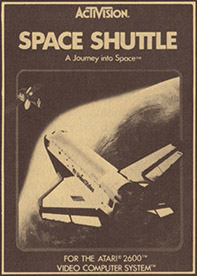
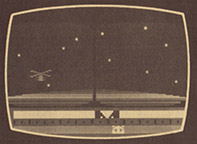
J.C.: From the moment dawn breaks over Cape Canaveral, to the time the runway slips under your wheels, you are in the grip of a remarkable cartridge.
No shooting, no killing, no enemies: just the pilot, his/her craft, and a ‘routine’ space rendezvous. Your attention is held by the constant onslaught of information about pitch and yaw, about the amount of fuel remaining, about the location of the satellite, by the sequence of events which bring you safely up and return you to earth in one place.
Activision has taken what would otherwise be a static view from the cockpit window and filled it with the colors, sights, and sounds of space. There’s really a sense of adventure when you plug in this game; a chance for grownups to recapture the sense of play that vanished when they folded away the cowboy suit and holster.
This is a landmark game, not only in terms of its unique gameplay, but as an entertaining and sophisticated learning tool. I wish Activision success with Space Shuttle.
Graphics: A
Gameplay: A
E.C.M.: I think the cold reality and by-now “commonplace” nature of the Space Shuttle is going to put a lot of consumers off. That’s too bad, because this game has all the Right Stuff.
In addition to the attributes mentioned by Jim—and I agree with his lavish praise—the instruction manual provides an illustrated guide to what’s happening outside your craft while you’re stuck with the view from your command chair.
I also like the codebook section of the manual, which adds to the verisimilitude of the game.
Our space program, too-long neglected by the dolts in Washington, deserves a boost. Hopefully, this videogame will help to provide it.
(Editor’s note: please refer to VCI #5 to see what a Space Shuttle astronaut had to say about videogames.)
QUICK STEP
Imagic for the 2600
Object
A one or two player game in which a Kangaroo and Squirrel hop from Mat-to-Mat collecting points.
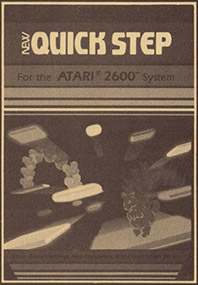
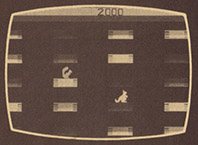
Jumping around a scrolling field, the animals try to accomplish several things: to change each Mat to their own color by hopping on it; to make sure it remains that color until the Mat scrolls off the bottom of the screen; to hit Magic Mats, which paralyze your opponent; to make a limited number of Mats disappear, thus trapping your adversary on a Mat which is scrolling off the screen (thereby destroying that animal’s life); and to land on a Gold Mat, which empowers you to make more Mats disappear.
Animals can jump up and down and from side to side. Points are scored when you are the first to change a fresh Mat to your color, and a Mat your color scrolls off the screen.
J.C.: An appealing variation of Q*Bert. The mats move fast, and because of their speed it’s necessary to stay on your toes.
There is a good deal of business to watch out for in Quick Step: the special-colored Mats, trying to trap your opponent, watching that you don’t get paralyzed on a vanishing level of Mats, and making certain as many Mats as possible are your color. Too, the computer plays a mean game, taking the part of the Squirrel and running your Kangaroo ragged.
Visually, the game is way below par. There is no characterization at all, and the screen is pale-colored Mats on black. Not very appealing, that. Imagic has opted to pack speed and real rivalry into this game. If you don’t mind bare bones scenery, you’ll have fun.
Graphics: D+
Gameplay: B-
E.C.M.: Unlike Q*Bert, Quick Step is a needlessly convoluted game. The problem is that it would work great on an arcade screen, where you’ve got the height to execute real strategies. In this game, the Mats scroll from the bottom of the screen before you can really get any strategies cooking.
The problem, of course, goes beyond the size of the screen. The game is fundamentally ill-conceived. Imagic has tried to combine the Q*Bert theme with the intellectualism of an Othello. Unfortunately, it doesn’t gel. It’s like trying to play Chess with your royal pieces constantly being lost as the bottom of the board scrolls away.
Frenzy can be a neat quality in a game like Venture. But there’s very little point to Quick Step other than to make players crazy.
Graphics: D
Gameplay: D+
LASER GATES
Imagic for the 2600
Object
The Cryptic Computer, a system for maintaining peace throughout the galaxy, has malfunctioned. All the fail safe systems designed to protect the Computer in its peaceful mode now keep humankind from disarming it in its rebellious mode.
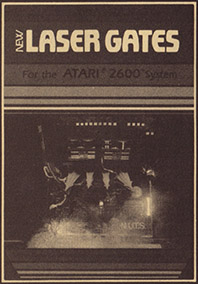
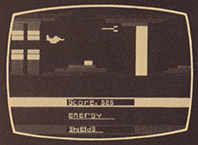
If four Detonators inside the labyrinthine computer are not destroyed, the computer will blow up the galaxy.
The heroic Dante Dart is sent to spiral through the Forcefields, Radar Mortars, Homing Missiles, Rock Munchers, and other obstacles to pick off the Detonators.
E.C.M.: Whatever possessed Imagic to dish up another Vanguard, Cosmic Avenger, Flash Gordon game is anyone’s guess. They did manage to give the Space Invaders theme new life with Demon Attack a few years back, but their muse has failed them here. Miserably.
Let’s just say that there is little new in Laser Gates. To say anything more would be unnecessarily cruel to this fast-sinking company.
Graphics: D+
Gameplay: D
J.C.: E.C.’s basic complaint is a fair one. This is another horizontal shoot-em-up with too few new twists: the Flexing Forcefield—a scrolling wall with a narrow gap for safe passage; the Computer Wall-in which you must shoot a tunnel; walls which vanish and reappear to impede your progress; it’s all been done to death.
Having to shoot out the pins of the Detonators is a clever device, but it’s not enough to justify buying the cartridge. Even the graphics are weak. How Imagic could do such an innovative and spectacular job on Moonsweeper and fail so dramatically with Laser Gates is one of those Great Mysteries of Life. However, it’s beginning to look like Imagic won’t have to worry about honoring those two year limited warranties on its cartridges….
Graphics: D-
Gameplay: D
MICRO TAKES
Donkey Kong Jr.
Coleco for Intellivision
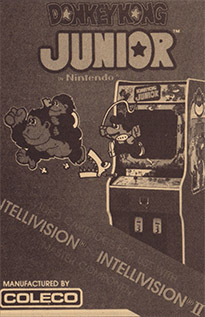
Object: Scurry a little ape up vines and chains, avoiding roving jaws and destructive birds to reach the top of the screen and free the imprisoned Donkey Kong.
J.C.: A very colorful but unsatisfying game. The graphics are merely okay; worse, there’s actually a second-long delay between the time you touch a fruit and it falls. C
E.C.M.: A ripoff. I was especially disappointed in the poor definition of the characters. This is another example of Coleco delivering inadequate goods for competing systems. Whoever programmed the ‘Tarzan’ yell when Jr. jumps ought to be boxed and shipped to Mars to prevent future atrocities. D+
Pole Position
Atari for the 5200
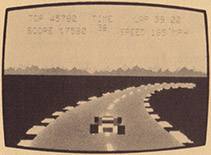
Object: Race around a twining track, shifting gears, slowing and speeding up, trying to beat the clock while avoiding collisions with other cars.
J.C.: It’s the same old 5200 story for arcade adaptations: graphics are better than the 2600 version, not quite up to the coin-op version. Gameplay is remarkably close to the latter. B
E.C.M.: Ignoring the fact that this genre is getting very tired, and we’ve got Pole Position II coming to the arcades in a few weeks, in and of itself this is a visual treat and a challenging cartridge, far better than Turbo for comparable ColecoVision. B
Ms. Pac-Man
Atari for the 5200
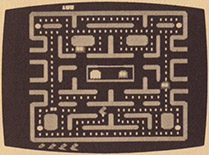
Object: Manuever the masticating madame through a maze of dots, avoiding predacious ghosts.
E.C.M.: Yesterday’s soup warmed over; I’ve had my fill of the Pac-Whatevers. A serviceable adaptation, if, like all the Atari Pac-Games, you don’t mind adjusting to a field wider than it is tall. C+
J.C.: My big problem remains the fact that the 5200 joystick doesn’t automatically return to neutral when you release it. Your Pac-Person tends to go off unattended. Otherwise, this cartridge captures the feel, gameplay, sounds, and graphics of the arcade original. B+
Time Pilot
Coleco for the 2600
Object: Eliminate all aerial enemies in five different time periods starting in 1910 and winding up in the year 2001.
E.C.M.: I suppose it was inevitable that Coleco would release this game in other formats; I only wish they could have made it more interesting. As with its ColecoVision version the graphics are very sparse: just clouds and planes. Anyone who has the Combat cartridge that came with the Atari system need not purchase this game. C
J.C.: While I agree with E.C. about the sparseness of the graphics, I disagree about the game’s worth. This is a very entertaining game, and far more enjoyable than the fighter pilot mode on the Combat cartridge, especially when you reach the ‘copters, jets and saucers of the later time periods. C+
Source Pages










